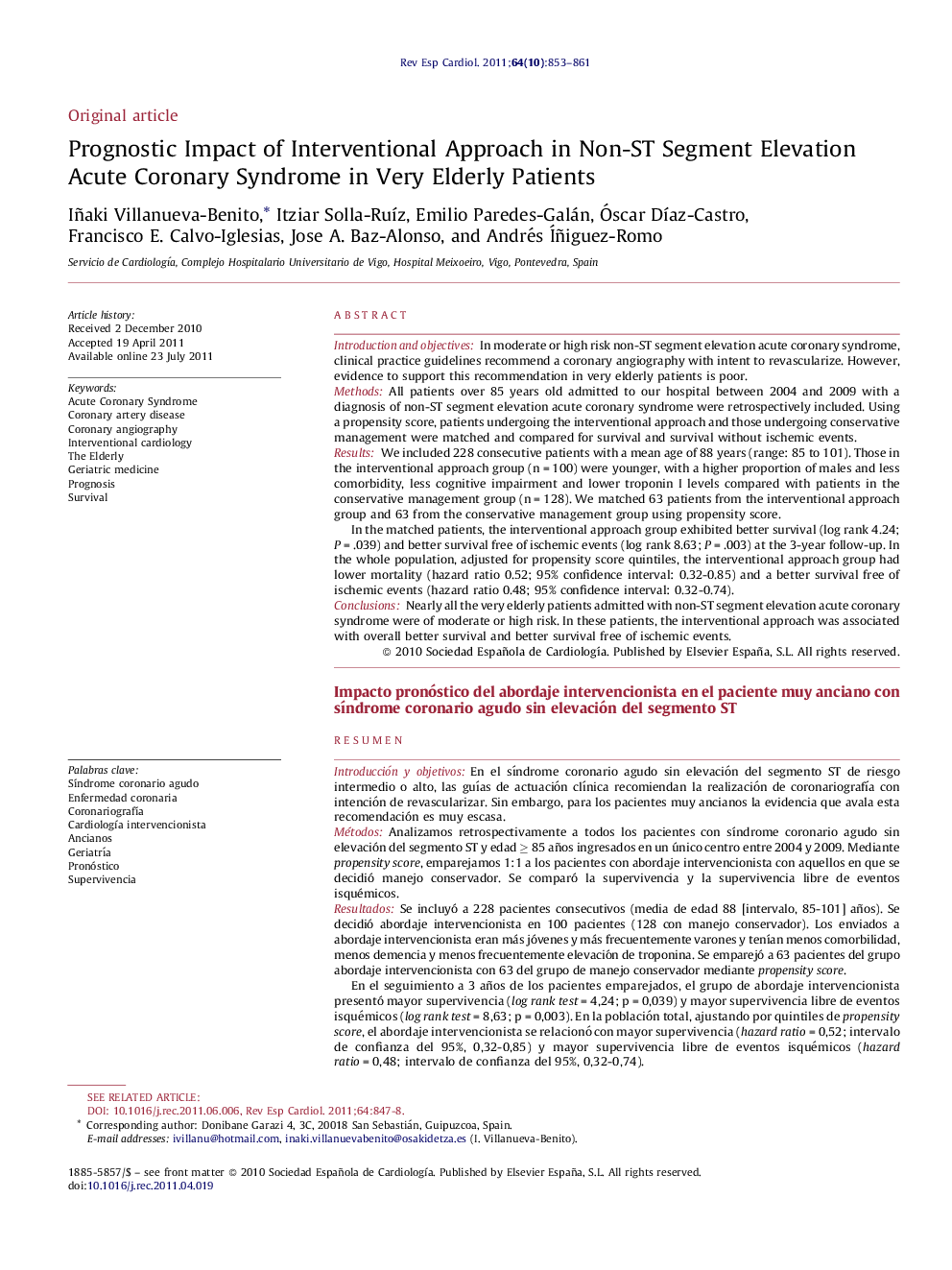| Article ID | Journal | Published Year | Pages | File Type |
|---|---|---|---|---|
| 3018375 | Revista Española de Cardiología (English Edition) | 2011 | 9 Pages |
Introduction and objectivesIn moderate or high risk non-ST segment elevation acute coronary syndrome, clinical practice guidelines recommend a coronary angiography with intent to revascularize. However, evidence to support this recommendation in very elderly patients is poor.MethodsAll patients over 85 years old admitted to our hospital between 2004 and 2009 with a diagnosis of non-ST segment elevation acute coronary syndrome were retrospectively included. Using a propensity score, patients undergoing the interventional approach and those undergoing conservative management were matched and compared for survival and survival without ischemic events.ResultsWe included 228 consecutive patients with a mean age of 88 years (range: 85 to 101). Those in the interventional approach group (n = 100) were younger, with a higher proportion of males and less comorbidity, less cognitive impairment and lower troponin I levels compared with patients in the conservative management group (n = 128). We matched 63 patients from the interventional approach group and 63 from the conservative management group using propensity score.In the matched patients, the interventional approach group exhibited better survival (log rank 4.24; P = .039) and better survival free of ischemic events (log rank 8.63; P = .003) at the 3-year follow-up. In the whole population, adjusted for propensity score quintiles, the interventional approach group had lower mortality (hazard ratio 0.52; 95% confidence interval: 0.32-0.85) and a better survival free of ischemic events (hazard ratio 0.48; 95% confidence interval: 0.32-0.74).ConclusionsNearly all the very elderly patients admitted with non-ST segment elevation acute coronary syndrome were of moderate or high risk. In these patients, the interventional approach was associated with overall better survival and better survival free of ischemic events.
ResumenIntroducción y objetivosEn el síndrome coronario agudo sin elevación del segmento ST de riesgo intermedio o alto, las guías de actuación clínica recomiendan la realización de coronariografía con intención de revascularizar. Sin embargo, para los pacientes muy ancianos la evidencia que avala esta recomendación es muy escasa.MétodosAnalizamos retrospectivamente a todos los pacientes con síndrome coronario agudo sin elevación del segmento ST y edad ≥ 85 años ingresados en un único centro entre 2004 y 2009. Mediante propensity score, emparejamos 1:1 a los pacientes con abordaje intervencionista con aquellos en que se decidió manejo conservador. Se comparó la supervivencia y la supervivencia libre de eventos isquémicos.ResultadosSe incluyó a 228 pacientes consecutivos (media de edad 88 [intervalo, 85-101] años). Se decidió abordaje intervencionista en 100 pacientes (128 con manejo conservador). Los enviados a abordaje intervencionista eran más jóvenes y más frecuentemente varones y tenían menos comorbilidad, menos demencia y menos frecuentemente elevación de troponina. Se emparejó a 63 pacientes del grupo abordaje intervencionista con 63 del grupo de manejo conservador mediante propensity score.En el seguimiento a 3 años de los pacientes emparejados, el grupo de abordaje intervencionista presentó mayor supervivencia (log rank test = 4,24; p = 0,039) y mayor supervivencia libre de eventos isquémicos (log rank test = 8,63; p = 0,003). En la población total, ajustando por quintiles de propensity score, el abordaje intervencionista se relacionó con mayor supervivencia (hazard ratio = 0,52; intervalo de confianza del 95%, 0,32-0,85) y mayor supervivencia libre de eventos isquémicos (hazard ratio = 0,48; intervalo de confianza del 95%, 0,32-0,74).ConclusionesCasi todos los pacientes muy ancianos ingresados por síndrome coronario agudo sin elevación del segmento ST están en riesgo intermedio-alto. En estos pacientes, el abordaje intervencionista se relaciona con mayor supervivencia y mayor supervivencia libre de eventos isquémicos.
